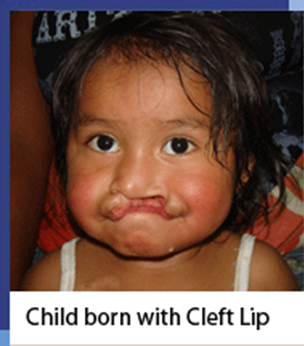Cleft lip and cleft palate is one of the most common major birth defects, occurring in approximately 1 of every 700 births in the United States. This occurs when the lip or mouth tissues do not form properly during pregnancy.
A cleft lip is easy to see and relatively simple to treat. The goal is to close the opening in the upper lip and restore the child′s ability to eat and speak.
An opening between the palate (the roof of your mouth) and the floor of the nose is known as Cleft Palate.
Cleft lip and palate can occur as an isolated event or in conjunction with over 400 different syndromes. It is important that if your child is born with a facial cleft that they are evaluated for other birth defects.
How Do I know If My Child Has a Cleft Lip or Cleft Palate?
Both cleft lip and cleft palate can vary in size from a narrow opening to a large hole in the roof of the mouth (cleft palate) or a complete split of the upper lip extending to the base of the nose (cleft lip). The diagnosis is often times made at birth or soon after, but is increasingly diagnosed in the prenatal period with the use of ultrasound.
We are available to provide prenatal counseling in the event that your child is diagnosed with a cleft before birth, or in the nursery after your child is born. We are aware that this can be an extremely difficult and confusing time, and are help to help you in anyway possible.

What Are the Difficulties With a Cleft Lip or Cleft Palate?
Depending on the severity, a cleft lip or palate can cause severe consequences for a child´s ability to speak, breathe, eat and as they grow older may also cause psychological problems.
What is the Treatment Plan for Cleft Lip or Cleft Palate?
Cleft lip and palate surgery can significantly improve your child´s facial appearance, ability to eat, breathe, speak and the defect can be corrected early on in their childhood.
A cleft lip is a relatively simple surgical procedure to close the gap in the upper lip, performed usually on a baby soon after birth (3-4 months).
Surgery to repair a cleft palate is usually carried out when the child is 12 -18 months old.
Bone graft surgery to repair the alveolar portion of the cleft is carried out at age 6-11, and usually precedes the eruption of the permanent canine teeth. It may be necessary and appropriate for the child to undergo orthodontics (braces) prior to this procedure.
Children with cleft lips and or palates often require multiple surgeries following their initial repair. These can include scar revisions, pharyngeal flaps (to aid in speech improvement), rhinoplasty (nose surgery to correct deformities associated with the cleft), and corrective jaw surgery to accommodate jaw size discrepancies that form as a result of the cleft and scar tissue formed over time.
Treatment of your child´s cleft requires a team approach of several professionals to achieve the optimal results. We will work closely with a cleft team usually consisting of a speech pathologist, audiologist, otolaryngologist, orthodontist, and pediatrician.
